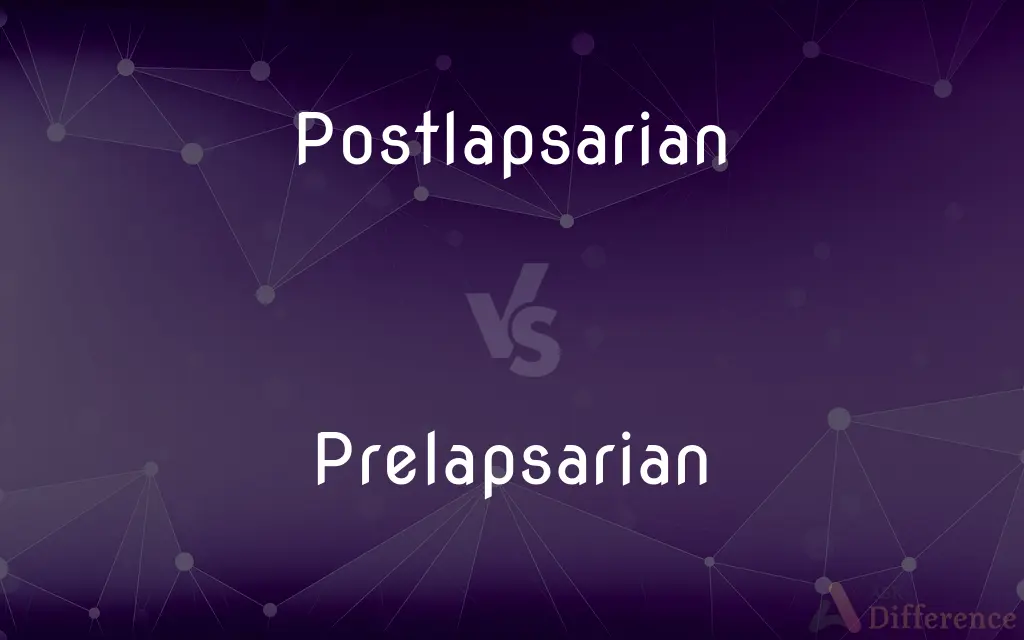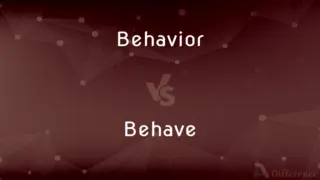Postlapsarian vs. Prelapsarian — What's the Difference?
Edited by Tayyaba Rehman — By Fiza Rafique — Updated on April 23, 2024
Postlapsarian refers to the state of humanity after the Fall of Man, emphasizing sin and moral fallibility, while prelapsarian pertains to the pure, sinless condition before the Fall.

Difference Between Postlapsarian and Prelapsarian
Table of Contents
ADVERTISEMENT
Key Differences
Postlapsarian theology focuses on human life and moral conditions after Adam and Eve's disobedience in the Garden of Eden, highlighting themes of sin and redemption. Whereas, prelapsarian perspectives consider the human state before this event, often idealizing human nature as innocent and uncorrupted.
Postlapsarian views are often linked with a recognition of inherent human flaws and a need for divine grace. On the other hand, prelapsarian thought tends to emphasize potential, purity, and an innate goodness in humans that was present before the Fall.
In literature and art, postlapsarian motifs typically depict struggle, suffering, and the complex realities of human life. Whereas, prelapsarian works might capture an idyllic, harmonious world unmarred by moral failings.
Theological debates frequently engage with postlapsarian concepts to address questions of morality, free will, and redemption. In contrast, prelapsarian discussions might focus on human potential and the philosophical implications of a perfect human state.
Comparison Chart
Definition
Pertaining to after the Fall of Man
Pertaining to before the Fall of Man
ADVERTISEMENT
Focus on Human Nature
Centers on inherent sinfulness and fallibility
Focuses on original purity and innocence
Theological Implications
Emphasizes the need for redemption and grace
Considers original blessings and potential
Representation in Art
Often portrays human struggle and corruption
Depicts idealized, harmonious existence
Usage in Literature
Explores themes of moral complexity and redemption
Often idealizes human nature and environment
Compare with Definitions
Postlapsarian
Describing a period marked by moral or spiritual decline.
The poet describes the era as distinctly postlapsarian.
Prelapsarian
Pertaining to the condition or time before the Fall of Man.
Prelapsarian innocence is a central theme in her artwork.
Postlapsarian
Characterized by the presence of inherent sin.
Postlapsarian theology deeply influences his writings on human nature.
Prelapsarian
Relating to an original state of purity.
The text explores prelapsarian human virtues and morals.
Postlapsarian
Pertaining to the fallen state of humans in religious contexts.
His sermon discussed the postlapsarian need for divine grace.
Prelapsarian
Pertaining to the ideal state of humans in theological studies.
Prelapsarian blessings are often debated among theologians.
Postlapsarian
Reflecting a view of humanity as corruptible and flawed.
The narrative portrays a deeply postlapsarian view of society.
Prelapsarian
Reflecting a view of humanity as inherently good.
His philosophical outlook is notably prelapsarian.
Postlapsarian
Relating to the time after the biblical Fall of Man.
The postlapsarian world in the novel is full of conflict and redemption.
Prelapsarian
Describing an idyllic, uncorrupted existence.
The setting of the story is distinctly prelapsarian.
Postlapsarian
(Theology) Of or relating to the period after the fall of Adam and Eve.
Prelapsarian
(Theology) Of or relating to the period before the fall of Adam and Eve.
Postlapsarian
Pertaining to anything which follows a lapse or failure.
Prelapsarian
Of, or relating to the period of innocence before the Fall of man; innocent, unspoiled.
Postlapsarian
The state of being which followed The Fall (the expulsion of Adam and Eve from the Garden of Eden).
Prelapsarian
Of or relating to the time before the Fall of Adam and Eve
Common Curiosities
How do postlapsarian views influence modern theology?
They influence discussions on moral responsibility, sin, and the need for grace in contemporary religious thought.
How do postlapsarian and prelapsarian views affect human self-perception?
Postlapsarian views might lead to a more cynical view of human potential, whereas prelapsarian views often inspire ideals of perfection and purity.
How is prelapsarian perspective different from postlapsarian?
Prelapsarian perspective views human nature as pure and innocent before the Fall, unlike the postlapsarian view which sees humans as inherently sinful.
What are some common themes in postlapsarian literature?
Common themes include human moral struggles, redemption, and the complex realities of a fallen world.
How do these concepts influence discussions on free will?
They frame debates on whether humans are predestined to sin (postlapsarian) or have the potential to choose goodness (prelapsarian).
What is the impact of these views on art and culture?
They shape how artists and cultures represent human nature and moral issues, often influencing the themes and tones of artistic works.
Are there any political implications of these theological concepts?
Yes, these concepts can influence views on governance, laws, and societal structures based on perceived human nature.
How does postlapsarian theology interpret the concept of grace?
It typically emphasizes the necessity of divine grace as a remedy for inherent human sinfulness.
What is postlapsarian theology?
Postlapsarian theology deals with human existence and nature after the Fall, focusing on themes of sin and redemption.
Can you provide an example of prelapsarian art?
Artworks that depict the Garden of Eden in its untouched state are examples of prelapsarian art.
What philosophical questions are raised by prelapsarian concepts?
Questions about human nature, the possibility of perfect existence, and the impact of inherent goodness.
How does postlapsarian belief affect literature?
It often leads to narratives that explore redemption, ethical dilemmas, and the complexities of human nature.
What role does prelapsarian ideology play in environmental discussions?
It sometimes inspires a return to natural, unspoiled states and critiques of modern environmental degradation.
Can prelapsarian views be seen as unrealistic?
Critics often argue that they idealize human nature too much, ignoring the complexities and challenges of real human behavior.
What impact do these theological views have on educational philosophies?
They can influence how sin, morality, and human potential are taught and understood in educational contexts.
Share Your Discovery

Previous Comparison
Checkerboard vs. Chessboard
Next Comparison
Behavior vs. BehaveAuthor Spotlight
Written by
Fiza RafiqueFiza Rafique is a skilled content writer at AskDifference.com, where she meticulously refines and enhances written pieces. Drawing from her vast editorial expertise, Fiza ensures clarity, accuracy, and precision in every article. Passionate about language, she continually seeks to elevate the quality of content for readers worldwide.
Edited by
Tayyaba RehmanTayyaba Rehman is a distinguished writer, currently serving as a primary contributor to askdifference.com. As a researcher in semantics and etymology, Tayyaba's passion for the complexity of languages and their distinctions has found a perfect home on the platform. Tayyaba delves into the intricacies of language, distinguishing between commonly confused words and phrases, thereby providing clarity for readers worldwide.
















































